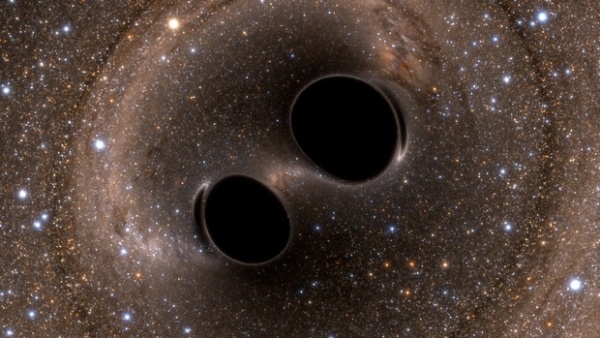A long, long time ago in a galaxy far, far away, two massive black holes met and merged into one, releasing more energy in the blink of an eye than do a trillion suns. Spacetime shuddered.
Over a billion years later, gravity waves rippling out through the Universe at the speed of light finally reached Earth, stretching it ever so slightly in one dimension while squeezing it in another. Two ultrasensitive detectors called “laser interferometers,” one at the Pacific Northwest Laboratory in Eastern Washington and the other in Louisiana, simultaneously detected this faint spacetime vibration in September 2015, triggering what promises to become a revolution in modern physics.
On Sunday, July 24, Caltech Professor of Physics Barry Barish will recount this spectacular scientific discovery in an Orcas Currents lecture titled “Gravity’s Music: Einstein, Black Holes and Cosmic Chirps.” Open to the public, it will begin at 5 p.m. in Orcas Center. Admission is free, but donations are welcome.
A high-energy physicist by training, Barish is a leader of the international LIGO Experiment that detected these waves, having served as the Principal Investigator and Founding Director of the LIGO Laboratory. He is widely credited as the manager who got these sprawling, L-shaped facilities built — each arm stretching four kilometers — enabling the discovery to occur. Listeners will get a ring-side seat on this discovery.
A member of the National Academy of Sciences and the American Academy of Arts and Sciences, Barish is a Fellow of the American Association for the Advancement of Science and the American Physical Society, in which he recently served as President. He has also served on the National Science Board, which advises the US President on science, engineering and education.
Since the original announcement of the gravity-wave discovery early this year, when it garnered front-page headlines throughout the world, the LIGO Experiment has revealed two additional events observed in late 2015 — almost one a month. When the interferometers are eventually tuned to their highest sensitivities, physicists expect to be able to detect almost one gravity-wave passing through Earth every day! Predicted 100 years ago by Albert Einstein in his General Theory of Relativity, gravity waves and the black-hole mergers that generate them are about to become commonplace events.
Based on these astonishing discoveries, theoretical physicists and cosmologists have begun to speculate that black holes make up much of the invisible “dark matter” thought to fill the Universe. Whatever the case, they are gaining priceless information about the nature and numbers of these cosmic vacuum cleaners.
Gravity-wave vibrations typically occur at frequencies that would be audible to the human ear, were it sensitive enough to hear them. Barish will play audio recordings of these “cosmic chirps” in his talk — a fitting prelude for music-loving Orcas Islanders and guests anticipating the opening of the chamber music festival early next month.



